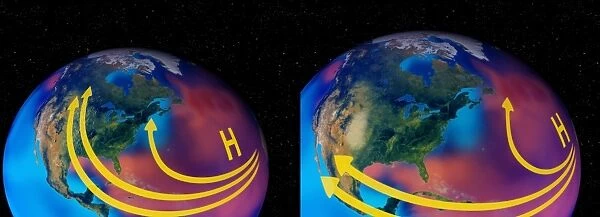Home > Science > Space Exploration > Related Images
1930s Dust Bowl drought explained C016 / 8123
![]()

Wall Art and Photo Gifts from Science Photo Library
1930s Dust Bowl drought explained C016 / 8123
1930s Dust Bowl drought explained. Computer artwork showing how, during the 1930s, cooler than normal tropical Pacific Ocean temperatures (blues) and warmer than normal tropical Atlantic Ocean temperatures (red and orange) contributed to a weakened low level jet stream and changed its course, leading to a Dust Bowl drought in North America. The jet stream normally flows westward over the Gulf of Mexico (lower left in each image) and then turns northward pulling up moisture and dumping rain onto the Great Plains. During the 1930s, this low level jet stream weakened, carrying less moisture, and shifted further south. The Great Plains land dried up and dust storms blew across the U.S
Science Photo Library features Science and Medical images including photos and illustrations
Media ID 9221101
© NASA/SCIENCE PHOTO LIBRARY
1930s Altered Arid Atmosphere Atmospheric Atmospheric Science Climatological Climatology Conditions Continent Cool Cooler Drought Dust Storm Environmental Science Explanation Gulf Of Mexico Jet Stream Meteorological Meteorology Pacific Ocean Storms Temperature Temperatures Warm Warmer Weak Weakened Weather Abnormal Condition Dust Bowl Explained Great Plains Low Level Physical
EDITORS COMMENTS
This print titled "1930s Dust Bowl drought explained" provides a visual representation of the environmental factors that contributed to one of the most devastating periods in American history. Created through computer artwork, it vividly illustrates how abnormal temperature patterns in the tropical Pacific and Atlantic Oceans altered the course of the low-level jet stream during the 1930s. In this image, cooler than normal temperatures are depicted by shades of blue in the Pacific Ocean, while warmer than normal temperatures appear as red and orange hues in the Atlantic Ocean. These contrasting oceanic conditions weakened and shifted the low-level jet stream southward from its usual westward flow over the Gulf of Mexico. As a result, less moisture was carried northward towards North America's Great Plains region. The consequences were dire: vast stretches of land dried up, creating arid conditions that led to severe dust storms across the United States. The once-fertile Great Plains turned into a barren landscape as crops failed and livelihoods were destroyed during this period known as "the Dirty Thirties". This thought-provoking artwork not only sheds light on historical climatological events but also serves as a reminder of how delicate our planet's atmospheric system is and how changes can have far-reaching impacts on human lives. It stands as an important testament to NASA's ongoing efforts to understand our environment and mitigate future risks associated with climate change.
MADE IN THE USA
Safe Shipping with 30 Day Money Back Guarantee
FREE PERSONALISATION*
We are proud to offer a range of customisation features including Personalised Captions, Color Filters and Picture Zoom Tools
SECURE PAYMENTS
We happily accept a wide range of payment options so you can pay for the things you need in the way that is most convenient for you
* Options may vary by product and licensing agreement. Zoomed Pictures can be adjusted in the Cart.

